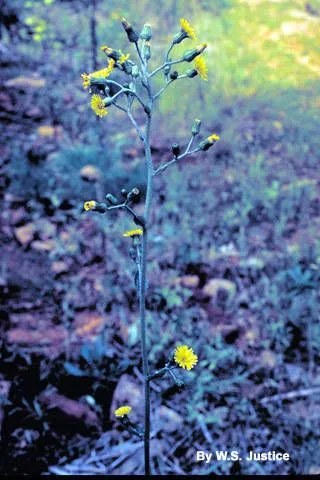
Author: Michx.
Bibliography: Fl. Bor.-Amer. 2: 86 (1803)
Year: 1803
Status: accepted
Rank: species
Genus: Hieracium
Vegetable: False
Observations: E. Canada to NC. & E. U.S.A.
Rough hawkweed, scientifically known as Hieracium scabrum, is a fascinating plant native to Eastern Canada and the eastern United States, stretching as far south as North Carolina. First documented in 1803 in Flora Boreali-Americana by the esteemed botanist Michaux, this resilient species is a notable member of the Asteraceae family.
Rough hawkweed is named for its distinctive rough, hairy texture which can be felt upon touching its leaves and stems. This texture helps differentiate it from other species within the hawkweed genus. The plant typically thrives in a variety of habitats, including open fields, meadows, and wooded areas where it enjoys partial to full sun exposure.
This wildflower produces bright yellow, dandelion-like blooms that bring a splash of color to its environment from late spring through summer. Each flower head is composed of numerous tiny florets, which together create a vibrant display that not only adds visual interest but also provides nectar and pollen for various pollinators, including bees and butterflies.
The erect stems and basal rosette of leaves are characteristic features of the rough hawkweed. The basal leaves are relatively broader and more ovate, while the upper leaves on the stem become progressively smaller and more lance-shaped. All leaves are covered with stiff, bristly hairs, contributing to the plant’s common name and making it easily identifiable.
Despite its beauty and ecological contributions, rough hawkweed can sometimes be considered a weedy species, especially in disturbed soils where it can spread quickly. Its ability to produce numerous seeds, dispersed by the wind, allows it to colonize new areas effectively.
In summary, rough hawkweed (Hieracium scabrum) is not only a botanical curiosity but also a significant component of the flora in its native range. Its rough texture, sunny blooms, and adaptability make it a plant worth recognizing and studying for both amateur botanists and seasoned researchers alike.
Eng: rough hawkweed, sticky hawkweed
Fra: épervière scabre
En: Rough hawkweed, Sticky hawkweed
Fr: Épervière scabre
Taken Jan 1, 1900 by EOL − Smithsonian Institution, National Museum of Natural History, Department of Botany (cc-by-nc-sa)
Taken Sep 6, 2013 by EOL − Robert L Curtis (cc-by-nc-sa)
Taken Mar 16, 2014 by EOL − Richard Spellenberg (cc-by-nc-sa)
Taken Mar 16, 2014 by EOL − Richard Spellenberg (cc-by-nc-sa)
Taken Sep 6, 2013 by EOL − Robert L Curtis (cc-by-nc-sa)
Taken Jan 1, 1900 by EOL − John Hilty (cc-by-nc)
Taken Jan 1, 1900 by EOL − John Hilty (cc-by-nc)
Taken Sep 6, 2013 by EOL − Robert L Curtis (cc-by-nc-sa)
Growth habit>: Forb/herb
Family: Myrtaceae Author: (F.Muell.) K.D.Hill & L.A.S.Johnson Bibliography: Telopea 6: 402 (1995) Year: 1995 Status:…
Family: Rubiaceae Author: Pierre ex A.Froehner Bibliography: Notizbl. Bot. Gart. Berlin-Dahlem 1: 237 (1897) Year:…
Family: Sapindaceae Author: Koidz. Bibliography: J. Coll. Sci. Imp. Univ. Tokyo 32(1): 38 (1911) Year:…
Family: Asteraceae Author: A.Gray Bibliography: Pacif. Railr. Rep.: 107 (1857) Year: 1857 Status: accepted Rank:…
Family: Fabaceae Author: Medik. Bibliography: Vorles. Churpfälz. Phys.-Ökon. Ges. 2: 398 (1787) Year: 1787 Status:…
Family: Aspleniaceae Author: (Cav.) Alston Bibliography: Bull. Misc. Inform. Kew 1932: 309 (1932) Year: 1932…